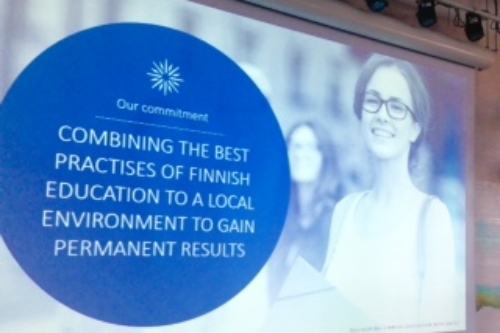
My colleagues and I have just returned from a week at Tampere University in Finland as part of an Erasmus project called Academic Adventures. The week began with an introduction to Finnish pedagogy and in this blog I want to share some insights into how and why educationally, Finland is regarded as one of the highest performing jurisdictions in the world. (At this point readers should feel free to make any comparison with the school system in this country as it once again undergoes a new Inspection framework and further curriculum changes).
Finland, a country of a population of 5.5 million and covering 338,455 km and whose GDP in 2018 was 234 million has a school system that has gone from relative mediocrity in the early 1990s to being now one of the most respected and successful educational systems in the world. In the international benchmark of education programmes known as PISA, Finland has come top or near the top in science, reading and mathematics each year since 2001. Maria Haapaniemi, CEO of Polar Partners, a company that exports the Finnish education system worldwide and who delivered the introductory lecture on the Erasmus programme, proudly boasts Finland as the top education system in the world, top for Primary education and second for higher education. Is there a magic formula for this success? One ingredient perhaps that has allowed this unique phenomenon? The answer I suggest lies in its educational policy to provide equal learning opportunities and well-being for all children.
The policy is not constantly changing nor rushed through, but has been developed gradually over time to allow time and space for teachers and children (NCEE, 2016). There is little competition amongst schools, no standardised testing and soft accountability. The country rejected the Global Education Reform Movement or GERM; the globalisation of education that has brought with it standardised testing and increased teacher accountability in the second half of the 2000s and now such a hallmark of so many industrialised countries.
Education is a fundamental right for all its citizens and this extends to its school systems, the structure from early education to higher education, curricula and methods of teaching, learning and assessment. It is a truly inclusive system: everyone has the same opportunities for education, regardless of age, ethnicity, ability or financial situation. It believes in promoting the potential of each individual child. It is 100% state funded. It has a long tradition in adult education and has a strong focus on lifelong learning. Teachers are recognised as key to high quality education and Finns value teaching as a career comparable with other professions like medicine and law where people build on knowledge and skills gained in their universities.
Pre-primary education is voluntary for six-year-olds, who then start their compulsory education in the following year. Meals, healthcare and travel, if the distance exceeds five kilometers, are provided free of charge. Compulsory education starts in the year when a child has his/her seventh birthday in what is known as 'basic education' which is also free of charge. Textbooks and other materials are free and pupils are offered a free daily meal. The Finnish higher education system has two parallel sectors: universities and polytechnics (or AMK institutions). Universities concentrate on academic and scientific research and education whereas polytechnics are more oriented towards more practical and vocational jobs.
Finland has a rigorous approach to preparing the next generation of teachers. They receive a research-based education programme in the Faculties of Education in one of its eight Universities. Prospective candidates must pass a national entrance examination lasting three hours. If successful they then process to an interview and once admitted they embark on a five-year degree programme, the final two years of which are at Masters level. One central focus of this is learning-focused curricula, assessing students' growth and learning by engaging in research and inquiry on a regular basis. Teachers spend four hours a day in the classroom and two hours a week are given to professional development activity.
The success ingredient is that the Finnish education policy is coherent and reflects a set of broad beliefs about equity, the centrality of children and their need for time, thinking, play, and choice, and a belief about teaching as professional and worthy of the utmost respect, value, and status. The system is also about well-qualified teachers with autonomy. About appropriate teaching and assessment methods and support for all children and curricula that blends academic with life skills. We know that one cannot import a system and expect it to be successful wholesale in another country, and certainly not where the ethos is different; but there are definite lessons for our system in England. Finland's lessons to us are about equity, trust and professionalism. Not bad for starters.
Dr Jonathan Doherty is a Senior Lecturer in the Institute of Childhood and Education at Leeds Trinity University. His professional interests are in education policy, teacher education, teachers' professional learning and social justice in education. Externally, he continues to sit on a number of national committees and Boards advising and informing on Early Years and Primary Education. He is currently on the Executive Committee of the National Primary Teacher Education Council; a member of the UCET CPD committee and the BERA Special Interest Group for Teacher Education.